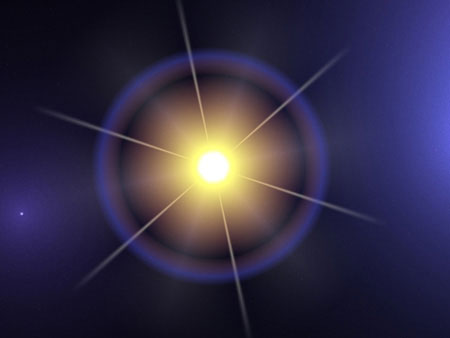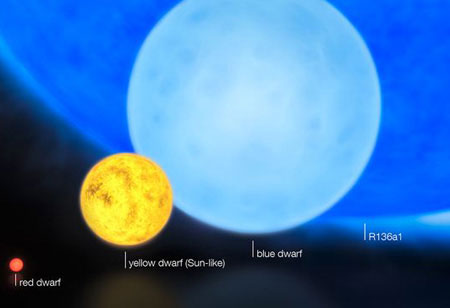The star is 20 million times brighter than the sun
International astronomers announced yesterday that they have found the heaviest star ever known by a large array of telescopes in Chile.

An illustration of a super big star on swri.edu page.
National Geographic reports that the star is named R136a1 and its current mass can be 265 times that of the sun. But at the time of formation, it can be 320 times heavier than the sun. Astronomers from England, Malaysia and Germany discovered it through the Very Large Telescope array in Chile. It is located between a large and newly born star cluster in the Large Magellanic Cloud, a galaxy about 165 thousand light-years away from the Milky Way.
The matter of stars decreases as their age increases, causing their mass to decrease over time. AFP thinks that with 20 million times the brightness of the sun, if R136a1 replaces the sun, the amount of ultraviolet radiation that the Earth receives from it will be so great that life cannot exist on our planet.
Professor Paul Crowther of the University of Sheffield, UK, who led the study, said: 'With a life of more than a million years, R136a1 is in the middle of its life cycle and loses a significant amount of matter. It lost about one-fifth of the amount of matter in the past, equivalent to more than 50 solar masses. I think R136a1's volume record will be hard to break in the near future. '
Crowther added that astronomers will have difficulty finding the origin of R136a1. "It is possible that such super-heavy stars are enormous in size from the time they were formed, or they are made up of many smaller stars," he said.

Illustration of red dwarfs (leftmost) yellow dwarf (including sun), blue dwarf and R136a1.Photo: National Geographic.
Richard Parkder, an astronomer at Shefffield University, said the new discovery could force astronomers to review some of the laws of physics in the universe. Scientists have long argued that the largest stars in the universe can only be 150 times as massive as the sun. If the star's mass is greater than that threshold, they think they cannot exist.
"R136a1 will change the way we think about the formation and destruction of stars" , Parkder commented.
- Detecting star clusters 30 million times brighter than the Sun.
- The star is brighter than the Sun.
- Photo of the universe: The star is 150 times brighter than the Sun.
- Detect extremely bright stars in the sky
- The supernova is 20 times brighter than the Milky Way
- The formation of the star is 300 times brighter than the Sun.
- The star is 10,000 times brighter than the Sun can prevent life from evolving
- The painful death of a star ripped apart by a supermassive black hole
- The scientific world is confused because the
- Comet is brighter than the full moon visiting Earth in 2013
- Stunned to find a source of cosmic rays from the star system Eta Carinae
- Discovering 'green spots' in the universe
 Van Allen's belt and evidence that the Apollo 11 mission to the Moon was myth
Van Allen's belt and evidence that the Apollo 11 mission to the Moon was myth The levels of civilization in the universe (Kardashev scale)
The levels of civilization in the universe (Kardashev scale) Today Mars, the sun and the Earth are aligned
Today Mars, the sun and the Earth are aligned The Amazon owner announced a secret plan to build a space base for thousands of people
The Amazon owner announced a secret plan to build a space base for thousands of people